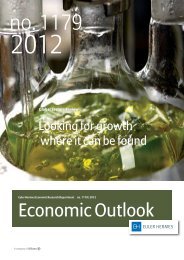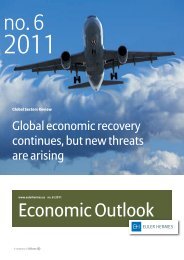Reindustrialization in USA - Euler Hermes
Reindustrialization in USA - Euler Hermes
Reindustrialization in USA - Euler Hermes
You also want an ePaper? Increase the reach of your titles
YUMPU automatically turns print PDFs into web optimized ePapers that Google loves.
Economic Outlook n° 1187 | Special Report | The <strong>Re<strong>in</strong>dustrialization</strong> of the United States<strong>Euler</strong> <strong>Hermes</strong>A new era of manufactur<strong>in</strong>g: “on-shor<strong>in</strong>g”The Ch<strong>in</strong>ese competitive edge <strong>in</strong> laborcosts has been so overwhelm<strong>in</strong>g that itoften eclipsed all other parameters <strong>in</strong> theeconomic and strategic equation. Therefreshed set of parameters of “Made <strong>in</strong>America” (cheap energy, supply cha<strong>in</strong> riskmanagement, etc.), are major advantagesto on-shor<strong>in</strong>g. Other factors <strong>in</strong>cludequality, easier communication, faster timeto market and cheaper <strong>in</strong>ventory costs.u While real American labor costs have barelychanged over the past decade, the dramatic <strong>in</strong>crease<strong>in</strong> Ch<strong>in</strong>ese wages has resulted <strong>in</strong> a steady erosion ofthe gap between American and Ch<strong>in</strong>ese wages. Forthe previous two decades this gap had been a crucial<strong>in</strong>centive for U.S. manufacturers to relocate <strong>in</strong>dustrialfacilities to Ch<strong>in</strong>a. Although there is no doubtthat the Ch<strong>in</strong>ese competitive edge is likely to rema<strong>in</strong>significant for a while, the recent years have markeda tipp<strong>in</strong>g po<strong>in</strong>t <strong>in</strong> the <strong>in</strong>dustrial relationship betweenthe two countries where<strong>in</strong> the wage gap will shr<strong>in</strong>kenough to become less important.Figure 14 below po<strong>in</strong>ts to a sharp <strong>in</strong>crease <strong>in</strong> Ch<strong>in</strong>esewages, fueled by buoyant economic growth despitethe determ<strong>in</strong>ation to keep <strong>in</strong>flation low, result<strong>in</strong>g <strong>in</strong>a sharp clos<strong>in</strong>g of the wage gap. Comb<strong>in</strong>ed with thedepreciation of the U.S. dollar versus the Ch<strong>in</strong>eseyuan, the supremacy of Ch<strong>in</strong>a as the best locationto manufacture is likely to be weakened <strong>in</strong> any case.The current and foreseeable global environment maypave the way toward the on-shor<strong>in</strong>g of <strong>in</strong>dustrialcapacities <strong>in</strong> the U.S. We assume the on-shor<strong>in</strong>g ofmanufactur<strong>in</strong>g capacities will ma<strong>in</strong>ly affect produc‐tion currently based <strong>in</strong> Ch<strong>in</strong>a but aimed at the U.S.market. This trend does not imply that the U.S. companieswill automatically scale back their operations<strong>in</strong> Ch<strong>in</strong>a.The sectors expected to be the most proactive <strong>in</strong>on-shor<strong>in</strong>g <strong>in</strong> the short and medium term can becharacterized by two conditions:• high exposure to labor costs <strong>in</strong> their coststructure; and• the ability to absorb higher labor costs by hav<strong>in</strong>ga lower labor cost component of value-added.Table D and Figure 15 below summarize the first andsecond tier of sectors which would <strong>in</strong>itially participateand contribute to on-shor<strong>in</strong>g. The activity potentiallyaffected by on-shor<strong>in</strong>g these <strong>in</strong>dustries from Ch<strong>in</strong>a tothe U.S. would be equal to the current exports to theU.S. from Ch<strong>in</strong>a <strong>in</strong> these two <strong>in</strong>dustries. This amountis estimated to be $282 billion annually. ©D. The Candidates for On-shor<strong>in</strong>gTier 1: Four sectors represent<strong>in</strong>g 56% of the U.S.imports from Ch<strong>in</strong>aComputer and electronic product manufactur<strong>in</strong>gU.S. import from Ch<strong>in</strong>a (<strong>in</strong> 2011)Mach<strong>in</strong>eryFurnitureMiscellaneous product manufactur<strong>in</strong>gTier 2: The ChallengersFabricated metal product manufactur<strong>in</strong>gElectrical equipment and appliancePlastic and rubber productsNon-metallic m<strong>in</strong>eral productsSource: Bureau of Economic Analysis, <strong>Euler</strong> <strong>Hermes</strong>$146bn$21bn$15bn$36bn$17bn$29bn$12bn$6bn14. Effective Manufactur<strong>in</strong>g Wage Gap302520$7USCh<strong>in</strong>a15. Part of labor costs <strong>in</strong> total operat<strong>in</strong>g costs and part of the value consumed by thelabor costs for each manufactur<strong>in</strong>g sector <strong>in</strong> 2011, <strong>in</strong> %0.70.60.50.40.31510$170.20.100 0.1 0.2 0.3 0.4 0.5 0.6 0.7 0.8 0.9 150200620072008200920102011assumptions:wages and yuan grow at historical rate 2006-19US worker 3.4X as productiveSource: Federal Reserve, Bureau of Labor Statistics, M<strong>in</strong>istry of Labor andSocial Security of Ch<strong>in</strong>a, Boston Consult<strong>in</strong>g Group and <strong>Euler</strong> <strong>Hermes</strong>2012201320142015Wood product Non-metallic product Primary metalFabricated metal productMach<strong>in</strong>eryComputer andElectrical equipment Motor vehicleelectronicOther transportationequipmentFurnitureMiscellaneousmanufactur<strong>in</strong>gFood and beverageTextileApparel Paper Pr<strong>in</strong>t<strong>in</strong>gPetroleum andcoal productChemical Plastics and rubber L<strong>in</strong>chp<strong>in</strong> (median)Source: Bureau of Economic Analysis, <strong>Euler</strong> <strong>Hermes</strong>17












